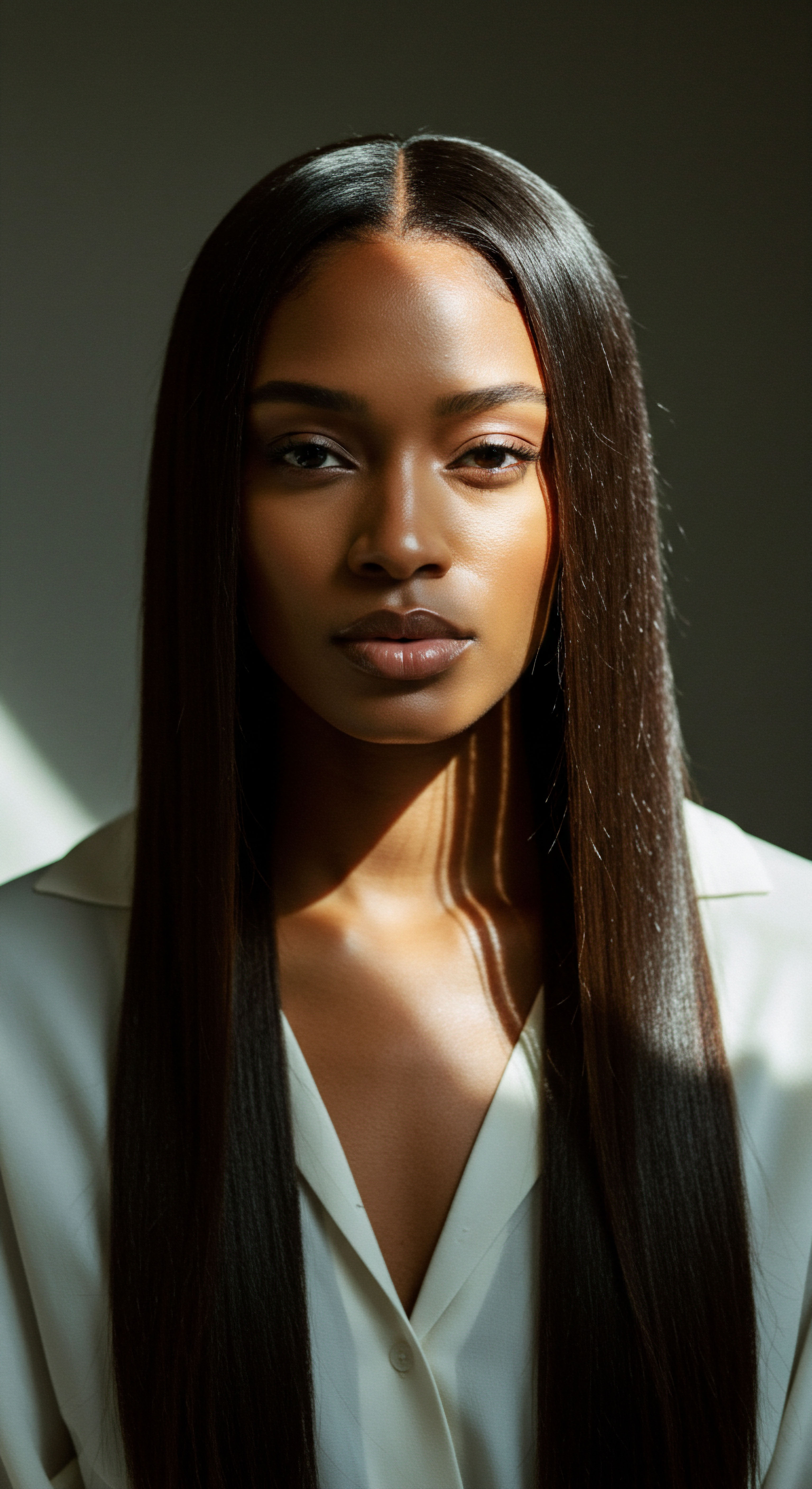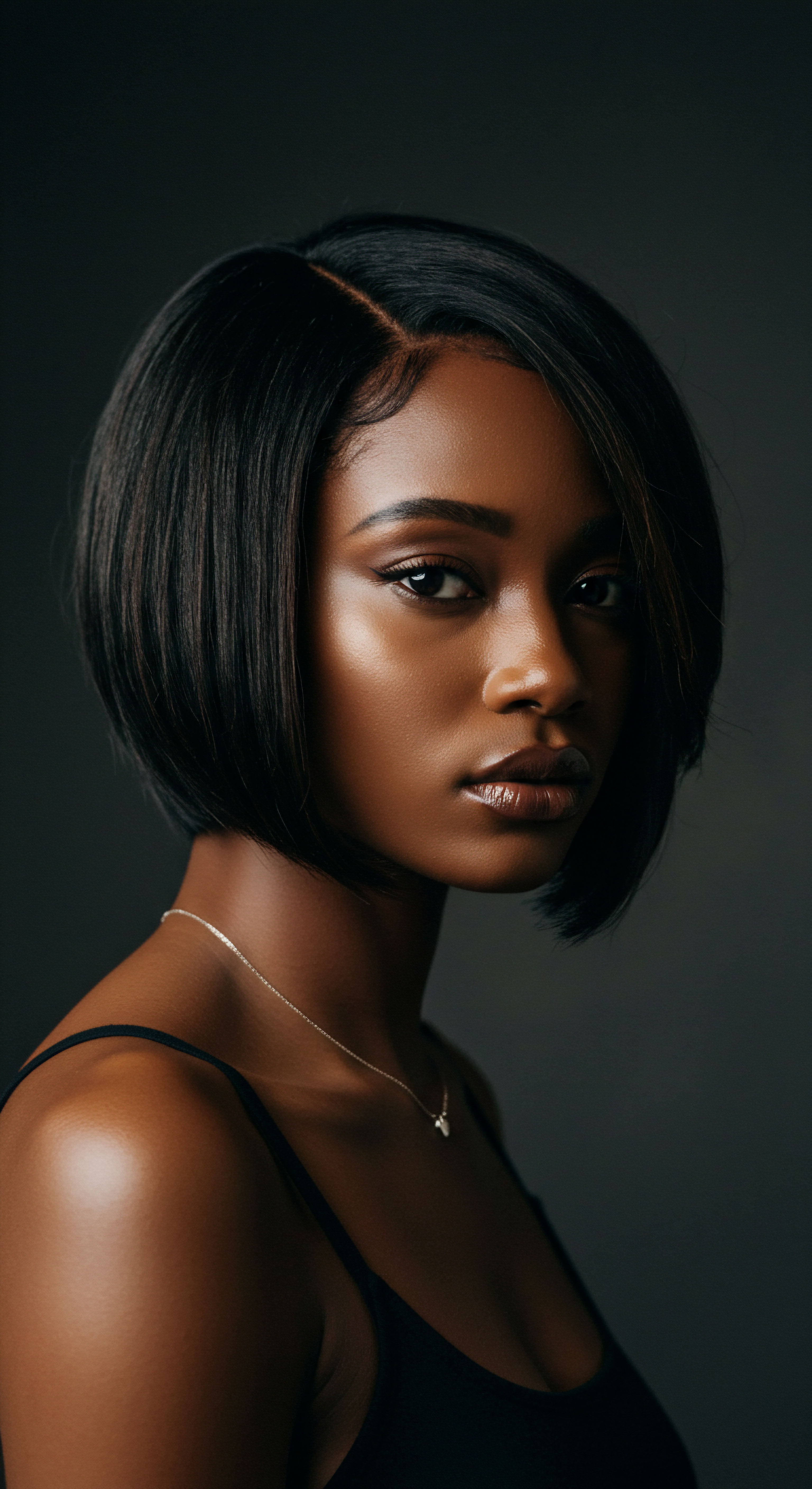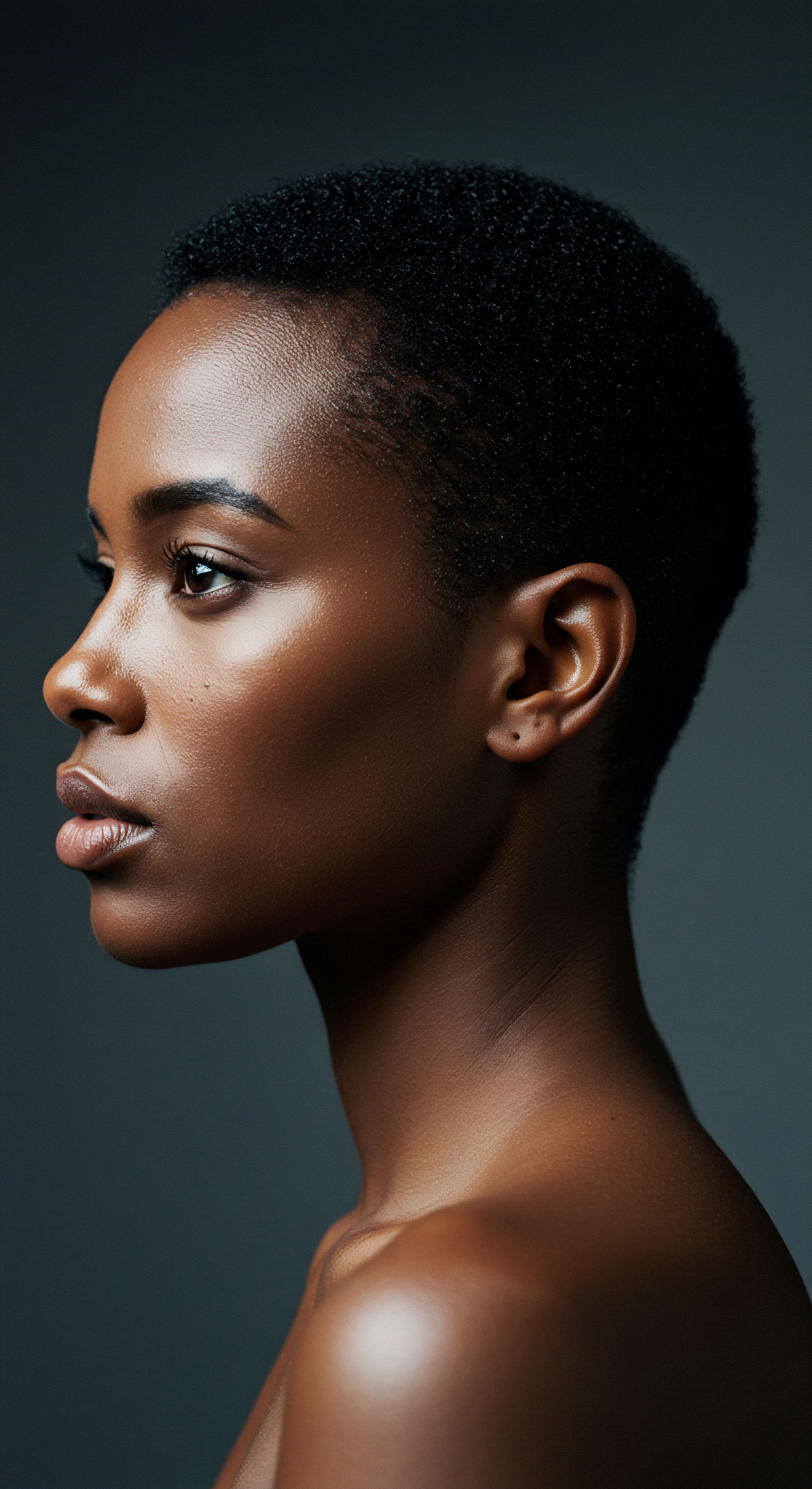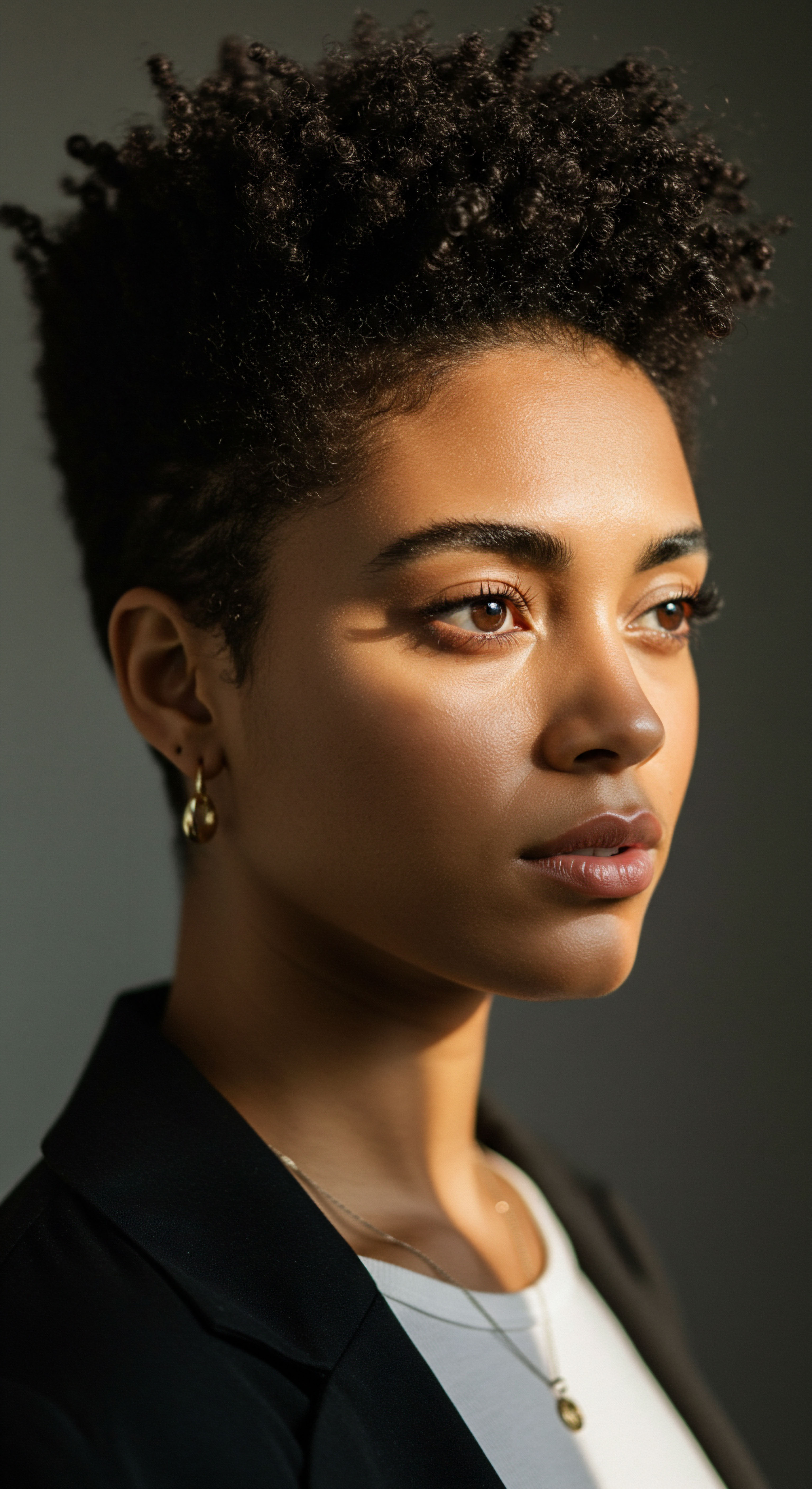
Roots
The very strands that crown us, a delicate testament to our heritage and daily experiences, are intimately tied to the world around them. We often consider the tangible aspects of hair care—the potions, the routines, the styling choices—yet, beneath the surface of these visible efforts lies a deeper, unseen conversation between our hair and its surroundings. This silent dialogue shapes a fundamental characteristic ❉ hair porosity. To truly understand our hair’s unique response, to nurture its inherent resilience, we must first attune ourselves to the elemental forces that whisper to its very structure, inviting or repelling the moisture it craves.

What Does Porosity Mean for Hair
Hair porosity speaks to the cuticle’s openness, that outermost layer of scales that acts as a guardian, regulating what enters and leaves the hair shaft. Imagine these scales like tiny shingles on a roof. When they lie flat and smooth, the hair possesses low porosity, meaning it resists moisture absorption but retains it well once hydrated. Water beads on its surface, taking time to soak in.
Conversely, when these scales are lifted or gapped, the hair exhibits high porosity. It readily absorbs water, almost greedily, yet just as quickly releases it, leading to a constant cycle of dryness and a thirst that seems unquenchable. Then there is the balanced middle ground, medium porosity, where the cuticle allows for a steady exchange, accepting moisture with ease and holding onto it with quiet grace. This natural variability is influenced by genetics, certainly, but the environment casts a powerful, ever-present spell upon this delicate balance.
Hair porosity, governed by the cuticle’s openness, dictates how readily strands absorb and retain moisture, a characteristic profoundly influenced by our surroundings.

The Cuticle’s Whisper
The hair cuticle, though microscopic, serves as a crucial interface between the inner workings of the hair and the external world. Its integrity is paramount to the hair’s overall well-being. When this protective layer is compromised, whether by harsh treatments or, pertinently, by environmental aggressors, the hair’s ability to manage its moisture content is directly impacted.
This compromise often manifests as increased porosity, leaving the hair vulnerable and more prone to breakage, dryness, and a general lack of vibrancy. Understanding this intricate interplay between the cuticle and its external influences provides the foundational wisdom for truly responsive hair care.
- Hair Cuticle ❉ The outermost layer of the hair shaft, composed of overlapping, flattened cells that regulate moisture flow.
- Low Porosity ❉ Hair with tightly closed cuticles, resisting moisture absorption but retaining it well once hydrated.
- High Porosity ❉ Hair with lifted or damaged cuticles, absorbing moisture quickly but losing it just as rapidly.

Ritual
Stepping from the elemental understanding of porosity, we arrive at the realm of daily practice and responsive action. Our hair, a living canvas, responds to the rhythms of our lives and the conditions of our immediate world. The question then becomes ❉ how do we consciously engage with these environmental influences, transforming challenge into a purposeful regimen? This section invites us to consider the thoughtful adjustments and protective measures that guide our strands toward sustained health and vitality, a gentle dialogue between intent and outcome.

Atmospheric Conditions and Hair’s Thirst
The air around us, in its varying states of humidity and dryness, profoundly influences hair porosity. In a dry climate, the air acts like a sponge, drawing moisture from everything, including our hair. This can lead to the cuticle lifting in an attempt to pull in more hydration, thereby increasing porosity and leaving strands feeling brittle and thirsty.
Conversely, in highly humid environments, hair with naturally high porosity might absorb excessive moisture from the air, leading to swelling, frizz, and a feeling of being weighed down. For those with low porosity, high humidity might simply sit on the surface, making hair feel greasy or heavy.

Responding to Humidity’s Embrace
Consider the humid embrace of a tropical climate. Hair, particularly textured hair with its inherent need for moisture, can react in diverse ways. For highly porous strands, this often translates to a battle against frizz as the hair rapidly absorbs water molecules, causing the shaft to swell unevenly.
For low porosity hair, the challenge might be product build-up and a lack of absorption, as the tightly bound cuticles repel the abundant atmospheric moisture. Tailoring a regimen involves selecting products that either seal the cuticle to prevent excessive absorption (for high porosity) or aid in deeper penetration (for low porosity) to avoid surface saturation.

Water Quality and Hair’s Reception
The very water we use to cleanse our hair carries its own environmental signature, a factor often overlooked in discussions of porosity. Hard water, rich in dissolved minerals like calcium and magnesium, leaves behind a residue that can accumulate on the hair shaft. This mineral buildup can obstruct the cuticle, making it difficult for moisture to enter or leave effectively, thereby altering the hair’s porosity over time. It can also cause the hair to feel rough, dull, and resistant to styling.
Chlorine, a common additive in tap water and swimming pools, is another potent environmental factor. Its oxidizing properties can strip hair of its natural oils, damage the cuticle, and lead to increased porosity and dryness.
The minerals in hard water and the chemicals in chlorinated water can disrupt the cuticle, significantly altering hair’s porosity and texture.
| Environmental Factor Dry Air |
| Impact on Cuticle Cuticle lifts to seek moisture |
| Typical Porosity Shift Can increase, leading to dryness |
| Environmental Factor High Humidity |
| Impact on Cuticle Excessive water absorption (high porosity) or surface saturation (low porosity) |
| Typical Porosity Shift Fluctuates; can exacerbate frizz or product build-up |
| Environmental Factor Hard Water Minerals |
| Impact on Cuticle Build-up, impeding moisture exchange |
| Typical Porosity Shift Can lead to varied porosity, often higher due to roughness |
| Environmental Factor Chlorine |
| Impact on Cuticle Stripping, cuticle damage |
| Typical Porosity Shift Increased, leading to dryness and brittleness |
| Environmental Factor Understanding these interactions informs more precise care. |

Solar Exposure and Hair’s Shield
The sun’s radiant energy, while life-giving, also poses a significant environmental challenge to hair, particularly its porosity. Ultraviolet (UV) radiation can degrade the hair’s protein structure, specifically keratin, and lift the cuticle layers. This process compromises the hair’s protective barrier, leading to an increase in porosity, making strands more susceptible to moisture loss and further damage. Prolonged sun exposure can also lighten hair color and contribute to a rougher texture, all symptomatic of an altered, more open cuticle.
- UV Protection ❉ Employing leave-in conditioners with UV filters or wearing protective head coverings can shield hair from sun-induced cuticle damage.
- Moisture Sealing ❉ Using heavier butters or oils after hydration can help seal the cuticle, particularly for highly porous hair, to prevent moisture evaporation in dry or sunny conditions.
- Chelating Shampoos ❉ Periodically using shampoos designed to remove mineral buildup can mitigate the porosity-altering effects of hard water.

Relay
Moving beyond the immediate observations and daily routines, we arrive at a more profound contemplation of how environmental factors shape hair porosity. This exploration transcends surface-level understanding, delving into the intricate scientific underpinnings and broader societal implications. It is here that we truly begin to connect the seemingly disparate threads of climate, chemistry, and cultural practices into a cohesive understanding of our hair’s delicate resilience. The complexities are many, the answers often nuanced, but the journey toward deeper insight is always worthwhile.

Does Air Pollution Alter Hair’s Structure
The invisible veil of air pollution, a constant companion in many urban landscapes, poses a significant threat to hair health and, by extension, its porosity. Particulate matter (PM2.5), heavy metals, and gaseous pollutants like sulfur dioxide and nitrogen oxides are not merely atmospheric concerns; they are direct aggressors to the hair shaft. These microscopic particles can deposit on the hair, creating a physical barrier that impedes proper moisture exchange.
Beyond surface deposition, certain pollutants can penetrate the cuticle, initiating oxidative stress within the hair fiber. This oxidative damage targets the hair’s structural proteins, particularly keratin, leading to the degradation of disulfide bonds and a loosening of the cuticle scales.
Research has consistently shown a direct correlation between exposure to polluted environments and compromised hair integrity. For instance, a study published in the Journal of Cosmetic Science observed that individuals living in highly polluted urban areas exhibited significantly higher levels of protein loss and cuticle lifting in their hair fibers compared to those in cleaner environments. The study pointed to specific environmental pollutants, including polycyclic aromatic hydrocarbons (PAHs) and heavy metals, as primary culprits in this structural degradation.
This protein loss and cuticle disruption directly translate to an increase in hair porosity, rendering the hair more vulnerable to breakage, color fading, and chronic dryness. The hair, in its attempt to cope with this external assault, often displays an elevated porosity as a consequence of its damaged protective layer.
Air pollution, particularly particulate matter and heavy metals, causes oxidative stress and protein loss in hair, directly increasing its porosity.

How Do Climatic Extremes Affect Hair Porosity Long Term
Beyond daily humidity fluctuations, sustained exposure to climatic extremes presents a unique challenge to hair porosity over time. Arid desert conditions, characterized by persistently low humidity and intense solar radiation, can lead to chronic dehydration of the hair fiber. The cuticle, in its desperate attempt to draw in moisture, remains perpetually open or lifted, leading to a state of sustained high porosity. This prolonged exposure can irreversibly alter the hair’s natural moisture balance, making it inherently more difficult to retain hydration even when moisture is applied.
Conversely, regions with consistently high humidity, while seemingly beneficial for moisture, can also challenge hair’s porosity equilibrium. For naturally high porosity hair, the constant influx of atmospheric water can lead to hygral fatigue – a state where the hair repeatedly swells and contracts, weakening the internal protein structure and further compromising the cuticle. This cycle can lead to a paradoxical situation where hair appears hydrated but lacks strength and elasticity, becoming mushy or overly soft when wet. For low porosity hair, persistent high humidity can prevent products from truly penetrating, leading to product buildup on the surface and a feeling of perpetual heaviness without genuine internal hydration.

The Interplay of Chemical and Physical Stressors
The impact of environmental factors on hair porosity is rarely a singular event; more often, it is a complex interplay of chemical and physical stressors. For example, hair regularly exposed to UV radiation (a physical stressor) while simultaneously encountering hard water (a chemical stressor) experiences a compounded effect. The UV radiation degrades proteins and lifts the cuticle, while the mineral deposits from hard water physically block the hair’s ability to absorb beneficial treatments and exacerbate the roughness of the cuticle.
This synergistic effect means that the hair’s porosity is not just incrementally increased but potentially drastically altered, demanding a holistic and responsive approach to care that addresses multiple environmental assaults. The historical and cultural context of hair care often accounts for these localized environmental challenges, developing specific practices and ingredients to mitigate their impact.

Reflection
Our hair, in its myriad textures and forms, is a profound echo of our personal stories and the world we inhabit. Understanding how environmental factors influence its porosity is not merely a scientific pursuit; it is an act of gentle observation, a listening to the whispers of our strands. This awareness allows us to move beyond reactive care, stepping into a space of proactive wisdom where we honor our hair’s unique needs, responding to its dialogue with the sun, the air, and the very water we use. It is a journey toward deeper connection, recognizing that true hair well-being blossoms from an intimate understanding of its delicate dance with the world.

References
- Kim, D. K. et al. “The effects of urban atmospheric pollution on hair.” Journal of Cosmetic Science, vol. 69, no. 3, 2018, pp. 185-195.
- Robbins, C. R. Chemical and Physical Behavior of Human Hair. 5th ed. Springer, 2012.
- Trueb, R. M. “The impact of environmental factors on hair loss.” Clinical Dermatology, vol. 37, no. 5, 2019, pp. 465-472.
- Giacomoni, P. U. Hair and Hair Care. Marcel Dekker, 1997.
- Feughelman, M. Mechanical Properties of Hair. Springer, 1997.
- Wall, J. C. “Hair Damage by UV Radiation.” Journal of the Society of Cosmetic Chemists, vol. 46, no. 2, 1995, pp. 69-83.
- Hoting, E. et al. “Effects of hard water on hair and skin.” International Journal of Cosmetic Science, vol. 27, no. 3, 2005, pp. 187-195.